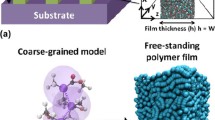Abstract.
We have used transmission ellipsometry to measure the glass transition temperature, Tg, of freely-standing films of atactic and syndiotactic poly(methyl methacrylate) (PMMA). We have prepared films with different molecular weights, MW, (159×103 < M w < 1.3×106) and film thicknesses, h, ( 30nm < h < 200 nm). For the high-MW ( M w > 509×103) atactic PMMA films, we find that Tg decreases linearly with decreasing h, which is qualitatively similar to previous results obtained for high-MW freely-standing polystyrene (PS) films. However, the overall magnitude of the Tg reduction is much less (by roughly a factor of three) for the high-MW freely-standing PMMA films than for freely-standing PS films of comparable MW and h. The observed differences between the freely-standing PMMA and PS film data suggest that differences in chemical structure determine the magnitude of the Tg reduction and we discuss the possible origins of these differences. Our analysis of the MW-dependence of the Tg reductions suggests that the mechanism responsible for the MW-dependent Tg reductions observed in the high-MW freely-standing films is different than that responsible for the MW-independent Tg reductions observed in the low-MW freely-standing and supported films.
Similar content being viewed by others
References
J.L. Keddie, R.A.L. Jones, R.A. Cory, Europhys. Lett. 27, 59 (1994).
J.L. Keddie, R.A.L. Jones, R.A. Cory, Faraday Discuss. 98, 219 (1994).
J.A. Forrest, K. Dalnoki-Veress, Adv. Colloid Interface Sci. 94, 167 (2001).
C.B. Roth, J.R. Dutcher, in Soft Materials: Structure and Dynamics, edited by J.R. Dutcher, A.G. Marangoni (Marcel Dekker, 2004).
M. Alcoutlabi, G.B. McKenna, J. Phys.: Condens. Matter 17, R461 (2005).
J. Baschnagel, F. Varnik, J. Phys.: Condens. Matter 17, R851 (2005).
C.J. Ellison, M.K. Mundra, J.M. Torkelson, Macromolecules 38, 1767 (2005).
J.A. Forrest, K. Dalnoki-Veress, J.R. Stevens, J.R. Dutcher, Phys. Rev. Lett. 77, 2002
J.A. Forrest, K. Dalnoki-Veress, J.R. Dutcher, Phys. Rev. E 56, 5705 (1997).
J.A. Forrest, K. Dalnoki-Veress, J.R. Stevens, J.R. Dutcher, Phys. Rev. E 58, 6109 (1998).
J.R. Dutcher, K. Dalnoki-Veress, J.A. Forrest, in Supramolecular Structure in Confined Geometries, edited by G. Warr, S. Manne, Am. Chem. Soc. Symp. Ser. 736, 127 (1999).
J. Mattsson, J.A. Forrest, L. Börjesson, Phys. Rev. E 62, 5187 (2000).
K. Dalnoki-Veress, J.A. Forrest, C. Murray, C. Gigault, J.R. Dutcher, Phys. Rev. E 63, 031801 (2001).
J.A. Forrest, J. Mattsson, Phys. Rev. E 61, R53 (2000).
E. Hempel, G. Hempel, A. Hensel, C. Schick, E. Donth, J. Phys. Chem. B 104, 2460 (2000).
C.B. Roth, J.R. Dutcher, Phys. Rev. E 72, 021803 (2005).
C.B. Roth, J.R. Dutcher, to be published in J. Polym. Sci., Part B: Polym. Phys. (2006).
Z. Fakhraai, S. Valadkhan, J.A. Forrest, Eur. Phys. J. E 18, 143 (2005).
P.G. de Gennes, Eur. Phys. J. E 2, 201 (2000).
P.G. de Gennes, C. R. Acad. Sci. Paris, Sér. IV 1, 1179 (2000).
D. Long, F. Lequeux, Eur. Phys. J. E 4, 371 (2001).
S. Merabia, P. Sotta, D. Long, Eur. Phys. J. E 15, 189 (2004).
S. Herminghaus, K. Jacobs, R. Seemann, Eur. Phys. J. E 5, 531 (2001).
S. Herminghaus, Eur. Phys. J. E 8, 237 (2002).
K. Ngai, Eur. Phys. J. E 8, 225 (2002).
K. Ngai, A.K. Rizos, Mater. Res. Soc. Symp. Proc. 455, 147 (1997).
C.J. Ellison, J.M. Torkelson, Nature Mater. 2, 695 (2003).
C.B. Roth, J.R. Dutcher, Eur. Phys. J. E 12, s01, 024 (2003).
The $R_{ee}$ values were determined using data given in Table XXXIX of P.J. Flory, Principles of Polymer Chemistry (Cornell University Press, Ithaca, 1953) p. 618.
We have not measured the tacticity content of the atactic PMMA, but an estimate of the relative isotactic and syndiotactic content can be obtained from the value of $T_g^{\text{bulk}}$. Higher $T_g^{\text{bulk}}$ values indicate a higher percentage of syndiotactic content
R.M.A. Azzam, N.M. Bashara, Ellipsometry and Polarized Light (North-Holland Publishing Company, Amsterdam, 1977).
No differences were observed in the measured $T_g$ values if the sample chamber was flushed for 15 min with dry nitrogen gas instead of only 30 s.
L.S.A. Smith, V. Schmitz, Polymer 29, 1871 (1988).
H. Shindo, I. Murakami, H. Yamamura, J. Polym. Sci., Part A: Polym. Chem. 7, 297 (1969).
S. Wu, J. Phys. Chem. 74, 632 (1970).
D.J. Plazek, K.L. Ngai, in Physical Properties of Polymers Handbook, edited by J.E. Mark (AIP, Woodbury, NY, 1996) Chapt. 12.
K.K. Chee, J. Appl. Polym. Sci. 43, 1205 (1991).
X.Y. Lu, B.Z. Jiang, Polymer 32, 471 (1991).
The possibility of a larger energy barrier for de Gennes' sliding mode for PMMA relative to that for PS is supported by the observation that, at $100\,^\circ$C, the monomeric friction coefficient $\zeta$ is $\sim 50 %$ greater for PMMA than for PS , see G.C. Berry, T.G. Fox, Adv. Polym. Sci. 5, 261 (1968).
R. Subramanian, R.D. Allen, J.E. McGrath, T.C. Ward, Polymer Prepr. 26, 238 (1985).
J.M. O'Reilly, R.A. Mosher, Macromolecules 14, 602 (1981).
Y. Grohens, R.E. Prud'homme, J. Schultz, Macromolecules 31, 2545 (1998).
P.R. Sundararajan, Macromolecules 19, 415 (1986).
M. Vacatello, P.J. Flory, Macromolecules 19, 405 (1986).
K. Schmidt-Rohr, A.S. Kulik, H.W. Beckham, A. Ohlemacher, U. Pawelzik, C. Boeffel, H.W. Spiess, Macromolecules 27, 4733 (1994).
S.C. Kuebler, D.J. Schaefer, C. Boeffel, U. Pawelzik, H.W. Spiess, Macromolecules 30, 6597 (1997).
Author information
Authors and Affiliations
Rights and permissions
About this article
Cite this article
Roth, C.B., Pound, A., Kamp, S.W. et al. Molecular-weight dependence of the glass transition temperature of freely-standing poly(methyl methacrylate) films. Eur. Phys. J. E 20, 441–448 (2006). https://doi.org/10.1140/epje/i2006-10034-0
Received:
Accepted:
Published:
Issue Date:
DOI: https://doi.org/10.1140/epje/i2006-10034-0




